Rinagry Cottage/Rinagry House
Houses within 15km of this house
Displaying 60 houses.
Houses within 15km of Rinagry Cottage/Rinagry House
Displaying 60 houses.
| House name | Description | |
|---|---|---|
| Ashbrook | An early 18th century house, it was noted by Wilson as the seat of Mr. Moore in 1786. It was occupied by Michael Costello in 1814 and described as in a dilapidated state at the time of the first Ordnance Survey. The Irish Tourist Association file refers to a two-storey plain featured house with the ruins of a small private chapel closeby, which apparently fell into decay in the early 19th century. Some ruins remain at the site. | |
| Oldcastle | Built by the McJordans of Ballylahan in the late 18th century. Slater refers to it as the seat of John Bolingbroke in 1846. There are modern buildings at the site now. |

|
| Oatlands House | The residence of the O'Dowds of Bunnyconnellan until the sale of their estate in 1854 when it was bought by Charles Downing and leased to Henry McLoghry. At the time of Griffith's Valuation Downing held it in fee when it was valued at £10. It is labelled Bunnyconnellan Cottage on the 1st edition Ordnance Survey Map but as Oatlands House on the 25-inch edition of the 1890s. This is the name by which it is still known. The Irish Tourist Association file refers to Oaklands House owned by Mr McAndrew in which some of the old O'Dowd house was probably incorporated. The house has been restored and in 2015 was offered for sale. | |
| Dove Hall | This house is labelled Dove Hall on the 1st edition Ordnance Survey map. A larger house, named Belgarrow House, is shown at the site on the 25-inch edition of the 1890s. It was occupied by Courtney Strogen and his descendants during the 19th century, held on lease from the Evans family. Occupied by John A. Knox in 1906. Belgarrow is now a ruin. | |
| Longfield House | Occupied by Colonel Kelly in 1814 and by Mrs Kelly in the 1830s. A house valued at £4 in this townland in the 1850s was occupied by Andrew Walsh. It is now a ruin. | |
| Bellavary | Charles Goodwin lived in the house in the late 1830s. The Landed Estates' Court rental records that Bellavary House was leased to Standish O'Grady McDermott by William Malley on 10 Feb 1859 for 21 years. It later became a Royal Irish Constabulary barracks and burned down in 1920. | |
| Moorbrook | In 1786 Wilson refers to "Moore-field" as the seat of Mr. Moore. Leet's Directory records 'Moorfield' as an 'unoccupied seat' in 1814. The house appears, however, to have become known as Moorbrook as it is thus labelled on the Ordnance Survey maps. Henry Wills held Moorbrook at the time of the sale in 1854. At the time of Griffith's Valuation, it is described as a "herd's house" and occupied by Francis O'Grady. It is labelled as "in ruins" on the 25-inch Ordnance survey map of the 1890s. A modern house has been constructed near the site. | |
| Cloongee | Originally a Moore home which was sold by Harloe Phibbs Baker to the McDermotts who lived there until the 20th century. At the time of Griffith's Valuation it was held in fee by Owen McDermott and valued at £7. The National Inventory of Architectural Heritage notes Cloongee as a rare survivor of a late-seventeenth century house in county Mayo. It is still extant and occupied. |

|
| Mullaghawny | Charles 'Sturgeon' (Strogen) was resident at Mullaghawny when Leet's Directory was compiled in 1814 and the Ordnance Survey Name Books refer to the dilapidated state of a mansion house in the townland of Mullaghawny belonging to Charles Strogen. Only a small portion of the buildings are visible on the 25-inch Ordnance Survey map of the 1890s. | |
| Sallymount | Home of Lewis Atkinson in the early 19th century. At the time of Griffith's Valuation the house was leased by Edward Atkinson from the Wingfield estate when it was valued at £4. The site is now occupied by farm buildings. | |
| Quignashee | Edward Howley occupied a property valued at £5 at Quignashee, barony of Tireragh, as well as 300 acres, at the time of Griffith's Valuation. Since 1898 this townland has been located in county Mayo. A building remains at the site. | |
| Rahans | The home of the Atkinson family, Wilson notes in 1786 that it was the residence of Charles Atkinson and "very pleasantly situated". It was occupied by the rector of Crossmolina, the Reverend Edwin Stock, for a few years prior to 1815. Rahans was described in 1855 as "a comfortable dwelling house, in a fair state of repair" and occupied by Mrs Frances Atkinson. At the time of Griffith's Valuation it was the home of George Orme. In 1925 Adelaide R. Orme of New South Wales sold Rahans demesne to Patrick J. Ruttledge of Ballina for £3,000, [see Acc. 1165/8/11 National Archives.] It is no longer extant. | |
| Ardnaree Rectory | At the time of Griffith's Valuation Rev. Joseph Verscoyle was occupying the house at Glebe, parish of Kilmoremoy, valued at £30. This house is no longer extant. | |
| Downhill | The house at Downhill is recorded as being built by Mr. Brennan, Merchant, Ballina. It appears, from the Ordnance Survey Name Books, that the townland of Knockalyre or Downhill was part of the Gore estate in 1836. Dr. McHugh of Ballina also had an interest in the property which he was renting to Rev. Thomas Feeney in 1857. Colonel Knox Gore also had a mill complex in this townland which, at the time of Griffith's Valuation, he was leasing to William Symes. Downhill House became a hotel when it was purchased by the Moylett family in 1936. |

|
| Ardnaree Cottage | Ardnaree Cottage dates to at least the early eighteenth century and possibly earlier. It was part of the Gore estate. Wilson, writing in 1786, refers to "Mr. Jones' charming demesne". In 1837 it was the residence of Thomas Jones and in 1857 it was leased by Col Arthur Knox Gore to Anne Hearne when it was valued at £10. The National Inventory of Architectural Heritage notes it as an important component of the domestic built heritage of Ballina. It is still extant and well-maintained. |

|
| Ballylahan | A property held by Pat McLaughlin from Sir William H Palmer in the early 19th century and by the Atkinsons at the time of Griffith's Valuation. Quinn writes that it was repossessed at the time of the expiration of their lease. It was a ruin by the publication of the 25-inch Ordnance Survey map of the 1890s. | |
| Carrowkeel | In the Ordnance Survey Name Books of the 1830s Carrowkeel House, the residence of Walter Bourke, is described as "in good repair". The house was valued at £6 at the time of Griffith's Valuation. It is labelled Carrowkeel House on the 1st edition Ordnance Survey map of 1838 but is not shown on the 25-inch edition of the 1890s. | |
| Croftonpark | ||
| Deel Castle | James Cuff, Lord Tyrawley, built a house beside the Old Bourke Castle in 1791. It is labelled Deel Castle on 1st edition Ordnance survey map but as Castle Gore on the later 25-inch edition The house was burnt in 1922 and not rebuilt. |
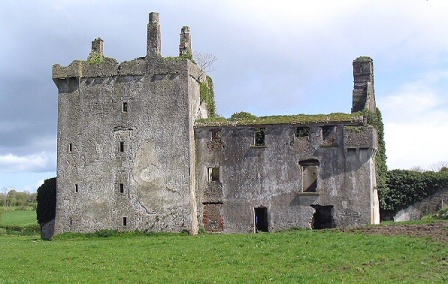
|
| Croftonpark | Described in the Ordnance Survey Name Books as a 'neat house', built in 1784 and occupied by Hugh Dane [Deane]. Robert Hunter lived there at the time of Griffith's Valuation and Patrick Ruane refers to the recent death of James Hunter, the owner of the house in the early 1990s. The house is still extant but no longer in use. |
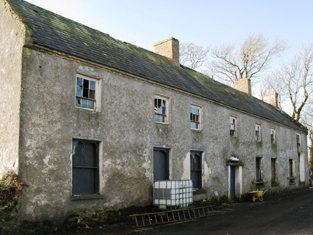
|
| Castle Gore | The old Bourke Castle on the river Deel was granted to the Gores at the end of 17th century. They added a large wing to the old castle in the 18th century and renamed it Castle Gore. The castle along with other lands was leased to James Cuff, Lord Tyrawley towards the end of the 18th century. Wilson refers to it as "the pleasant old seat of the Earl of Arran, now occupied by Rt. Hon. James Cuffe" in 1786. Occupied by the Cuff's steward for part of the 19th century. At the time of Griffith's Valuation it was occupied by Captain St. George Cuffe and valued at £60. In 1894 Slater refers to it as a seat of the Earls of Arran though this may refer to the late eighteenth century house nearby. |

|
| Belleek Castle/Ballina House | Edward J Howley held Belleek Castle and demesne on a lease originally granted by James O'Hara 2nd Lord Tyrawley to Vaughan Jones for 999 years, dated 25 Mar 1739. He was residing at Belleek in the 1830s. The Castle was leased to the Pery family in the late 1860s. It is now known as Ballina House. |

|
| Beaufield House | "Bowfield" House was occupied by E. Howley in the 1830s. On both the 1st and 25-inch editions of the Ordnance Survey maps the house is labelled Beaufield House. No house of more that £1 valuation was recorded in the townland of Carrowcastle at the time of Griffith's Valuation. It is no longer extant. | |
| Ellaghmore | Occupied by Edmund Howley in 1814 and by E. Howley in the 1830s. A house valued at £2.10 shillings was occupied by Bartholomew Higgins at the time of Griffith's Valuation. It is no longer extant. | |
| Carrowmore/Carramore | Wilson notes "Keromore" as the seat of Mr. Vaughan in 1786. The Ordnance Survey Name Books refer to the house as "a modern structure built in 1819". At the time of Griffith's Valuation it was held in fee by Captain O. Jackson and valued at £30. The Irish Tourist Association File states it was a guest house in the 1940s run by Mrs Reid. Bence Jones writes that it is now a ruin. | |
| Fortland | The Jacksons held this property from the Pratts of Enniscoe. It was described in the 1830s as a plain house ornamented with a few trees and scrubs. At the time of Griffith's Valuation it was leased by George H. Jackson from Mervyn Pratt when it was valued at £12. It is still extant ad now owned by Billy Cook. |

|
| Wood Park | This was the earlier house on this estate, shown as Woodpark on the 1st edition Ordnance Survey map of 1838. It was lived in by the Anderson family in the 1830s and 1840s. At the time of Griffith's Valuation it was held in fee by Thomas Jones and valued at £6. A house diminished in size but still labelled Wood Park is shown on the 25-inch map of the 1890s. This property does not appear to be extant now. [Charles Coyne also lived at Massbrook in the mid 19th century. See also under Massbrook] | |
| Enniscoe House | The site of an old Bourke castle on the shore of Lough Conn, the house was built before 1786 as Wilson refers to Prospect as the seat of Mr. Jackson at that time. It was held in fee by Mervyn Pratt at the time of Griffith's Valuation, when it was valued at £50. It appears as Inishcoe House on both the 1st and 25-inch ediitons Ordnance Survey maps but is now known as Enniscoe House. The North Mayo Family History centre is based in adjacent buildings and the house offers guest acommodation. |

|
| Mount Falcon | A lodge and offices were built in 1826. In 1876 the building of Mount Falcon Castle was completed. Bought by the Aldridges in 1932 the Castle was run as a country guest house in the latter part of the 20th century. Following the death of Mrs Aldridge in 2003 the property was bought by the Maloney brothers and is now run as a luxury hotel. See www.mountfalcon.com |

|
| Rappa Castle | An old Bourke castle, granted to a Cromwellian soldier named Crofton. It passed into Knox ownership through marriage and was the seat of this influential branch of the Knox family throughout the 18th and 19th centuries. In 1786 Wilson refers to it as "the pleasant seat of Mr. Knox". At the time of Griffith's Valuation it was held in fee by Annesley Knox and valued at £30. Slater notes it as the seat of Captain Annesley Knox in 1894. Occupied by the Knox family until the early 20th century, the house is now a ruin. |
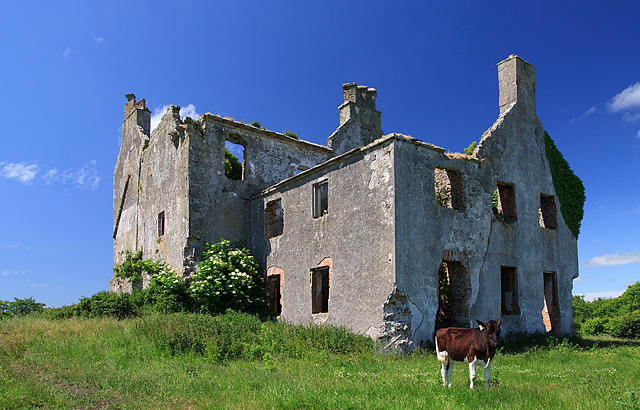
|
| Netley House | The home of Henry William Knox, fourth son of Francis Knox of Rappa, occupied by Richard Burke at the time of Griffith's Valuation when the house was valued at £30.. The house is now a ruin. |

|
| Belleek Manor/Abbey | Built in 1831 in the Gothic style. The seat of Maj.-Gen Saunders Knox-Gire in 1894. It was sold in 1940 to the Beckett family who resold it to Mayo County Council. It became a santorium but now functions as the hotel known as Belleek Castle. |

|
| Errew Grange | A Victorian Gothic house built circa 1870s. It was bought from Granville Knox by the Burkes of Ballina, solicitors. The Burkes leased it to the Order of Jesus and Mary before the Order moved to Gortnaraby in 1916. It became a hotel but burnt down in 1949 and was later restored. |
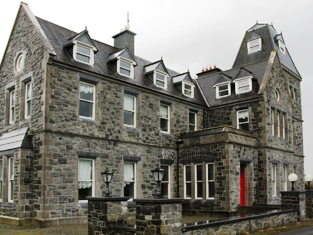
|
| Abbeytown | The original historical abbey buildings in this townland are described as 'in ruins' at the time of the first Ordnance Survey. It was formerly the residence of a Mr Crofton but was then occupied by a caretaker for the Orme family. Abbeytown House is shown a litte to the north on the later 25-inch map of the 1890s. The property was bought by Anthony Carolan of Crossmolina at the sale in 1852 and the house was later lived in by the parish priest. Abbeytown is still extant and occupied. |
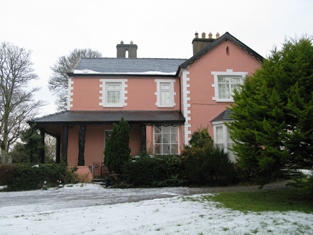
|
| Ballycarroon | A house dating from the early 19th century. At the time of Griffith's Valuation it was occupied by Isadore Andrew Lynch, who sub leased it from Henry Charlton. Later occupied by members of the Craven and Connor families. A house still exists at the site. | |
| Gortnaraby/Gortnor Abbey | Ruane dates this house to the mid 18th century.In 1786 Wilson refers to it as the seat of Mr. Ormsby. At the time of Griffith's Valuation, it was leased from John Ormsby by an individual named Connop and valued at £25. In 1916 it was taken over by the Order of Jesus and Mary and now functions as a secondary school. |

|
| Knockglass | The main residence of the Paget family in the 19th century. Afterwards it passed into the possession of Patrick Rowe and later served as the home of the Church of Ireland Bishop of Tuam, Achonry and Killala. In 2011 it was offered for sale. |

|
| Coolcronaun | Coolcronan House was built by Edmond Pery at the time of his marriage to Sarah Jane Knox Gore in the mid-nineteenth century. The family owned the property until the 1950s. The Irish Tourist Association File states that it was erected in 1860 by the Knox Gores. It was extensively renovated in the late 1990s and is still extant and available as holiday accommodation. See http://www.coolcronan.com. |

|
| Castlehill | In 1786 Wilson refers to Castlehill as the seat of Mr. [Mc]Cormack. The Cormacks lived at Castlehill until the mid 1830s. A new house was built in the late 1830s for John Walsh, an attorney of Hume Street, Dublin. At the time of Griffith's Valuation, it was held in fee by him and valued at £34. It was the residence of Edward Walsh in 1894. It is still extant. |
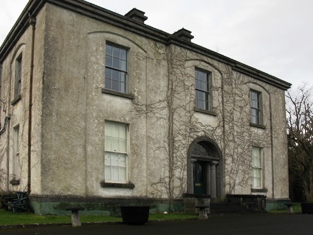
|
| Woodbine | A house belonging to the Gores, Earls of Arran, which was the residence of the Ham family until the 1860s, one of whom built the Upper Bridge over the River Moy in Ballina. The Hams subleased from the Jones family. The house was bought by Anne Elizabeth Jones in the early 1870s in trust for her son Henry Hastings Jones. The Jones family sold Woodbine to an American lady in 1939. It was offered for sale again in recent years. |
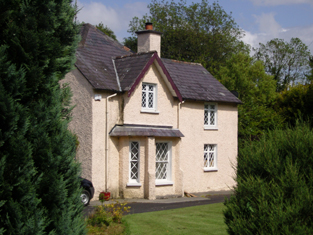
|
| Creggagh | The house valued at £6 was held by John Fair at the time of Griffith's Valuation but was unoccupied. In 1894 Slater noted it as the seat of Major D.R. Fair. It was occupied in the early decades of the twentieth century but is now a ruin surrounded by forestry. |

|
| Massbrook | The Irish Tourist Association file makes it clear that there were two houses at Massbrook, both in good condition in the 1940s. One was of French design erected in the 1890s by Colonel Johnston, the then owner of the estate. There was also an older and smaller house, see under Woodpark. D.15166 in the National Archives refers to the house and demesne of Massbrook in 1868. Described by Bence Jones as a late Victorian house, the seat of the Walsh family. In the early 1990s Mrs Mary Robinson, former President of Ireland, purchased the house known as Massbrook, formerly owned by Denis Ferranti. | |
| Rathmeel | The representatives of William Ormsby were leasing a property valued at £12 at Rathmeel, barony of Tireragh, to Augustus Bolton at the time of Griffith's Valuation. Extensive modern development has taken place in this area. | |
| Quignamanger | Charles Craig was leasing a property valued at £6 at Quigamanger, barony of Tireragh, from Edward Howley at the time of Griffith's Valuation. Since 1898 this townland has been located in county Mayo. Modern housing exists in this location now. | |
| Quignalecka | At the time of Griffith's Valuation Rev. James Lindsay was leasing a property valued at £5 at Quignalecka, to Capt. William Wright. Since 1898 this townland has been part of county Mayo. | |
| Mullenmore | In 1786, Wilson refers to Mullennore as the seat of Mr. Cormack, "pleasantly situated on the edge of Lough Conn". The townland was in the ownership of the Palmer estate at the time of Griffith's Valuation and there was no substantial house there. | |
| Carnisk | John Sproule was leasing this property from Sir James Stewart's estate at the time of Griffiths Valuation in the 1850s, when it was valued at £18. This appears to be the house labelled Carnisk on the 25-inch Ordnance Survey map of the early twentieth century. An earlier house, shown on the 1st edition Ordnance Survey map, was located nearby at C209209. A large farming complex exists at the Carnisk site now. | |
| Coolaghy Lower | Reverend George Hanson was leasing this property from the Abercorn estate at the time of Griffiths Valuation in the 1850s, when it was valued at £12. A substantial farm exists at the site. | |
| Galdonagh Upper | Charles Watson was leasing this property from the Abercorn estate at the time of Griffiths Valuation in the 1850s, when it was valued at £12. A hose and farm buildings are still extant at the site. | |
| Tullyrap | Alexander Finlay was leasing this property from the Abercorn estate at the time of Griffiths Valuation in the 1850s, when it was valued at £25 and had an adjacent mill. A substantial farm still occupies the site. | |
| Foyle View | Alexander Porter was leasing this property from the Abercorn estate at the time of Griffiths Valuation in the 1850s, when it was valued at £10. A farm still exists at the site. | |
| Tullyowen | Eliza Jane Campbell was leasing this property from the Abercorn estate at the time of Griffiths Valuation in the 1850s, when it was valued at £12. In 1786 Wilson noted it as a seat of a Mr Thomson. It does not appear to be extant now. | |
| Whitehill (Raphoe North) | James Browne was leasing this property from the Abercorn estate at the time of Griffiths Valuation in the 1850s, when it was valued at £11. A house is still extant at the site. | |
| Drumenan | James Alexander was leasing this property from the Abercorn estate at the time of Griffiths Valuation in the 1850s, when it was valued at £12. A house and farm are still extant at the site. | |
| Ardagh (Raphoe North) | Andrew Rolleston was leasing this property from the Abercorn estate at the time of Griffiths Valuation in the 1850s, when it was valued at £11. | |
| Raphoe Bishop's Palace | William Ker was leasing this property from the Ecclesiastical Commissioners estate at the time of Griffiths Valuation in the 1850s, when the buildings were valued at £45. The Bishop's Palace was destroyed by fire in 1838 and has remained a ruin ever since. |
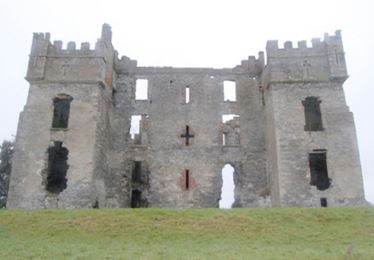
|
| Drumineney | David Wilson was leasing this property from the Ecclesiastical Commissioners estate at the time of Griffiths Valuation in the 1850s, when it was valued at £16. The National Inventory of Architectural Heritage suggests that the current house at this site was developed c.1870 from an earlier building. Robert Wilson was also leasing property in this townland at the same time. A house and extensive farm exist at the site. | |
| Tops (Raphoe) | John Wilson was leasing this property from the Ecclesiastical Commissioners estate at the time of Griffiths Valuation in the 1850s, when it was valued at £18. The National Inventory of Architectural Heritage suggests the current house was built c.1852 possibly on the site of an earlier house. Eliza Wilson was also leasing property at this location in the 1850s. |
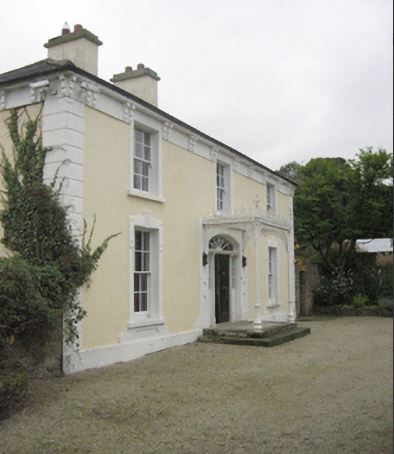
|
| Coolaghy (Raphoe) | William Hamilton was leasing this property from Reverend Lord Edward Chichester's estate at the time of Griffiths Valuation in the 1850s, when it was valued at £20. It appears to have been associated with the Hamilton family for much of the nineteenth and early twentieth centuries. It is still extant and occupied. |
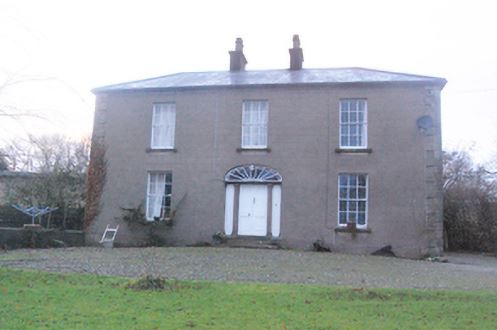
|
| Altaskin Lodge | Robert Rankin was leasing this property from the Ecclesiastical Commissioners estate at the time of Griffiths Valuation in the 1850s, when it was valued at £16. |

